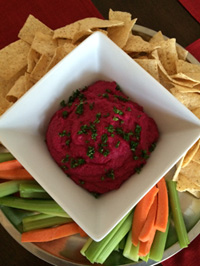Insider’s Viewpoint: How Fruit & Veggie Color Affects Your Health
When you think of fruits and vegetables, the spectacular colors of the produce aisle paint a vibrant mental image. You may be familiar with catchphrases like “eat the rainbow” and “color your plate,” and many recipes utilize fruits and veggies to add color and provide attractive garnish. Here at Kroger, some of our customers have noticed color-tinted water when rinsing, soaking, or cooking vegetables, and have wondered if added colors or dyes are to blame.
Are retailers or growers using added color to make those fresh broccoli florets bright green, or those canned beets deep purple? The answer is no; fruits and veggies are simply colored by nature! Natural plant pigments are responsible for the different hues, and many of these pigments happen to be water-soluble. So, that beautiful fresh beet will color your hands, counters, and dish water varying shades of gorgeous natural fuchsia, and your broccoli’s cooking water may appear bluish-green.
The natural plant pigments responsible for these observations are divided into several broad categories. Within each category there are individual compounds that may contribute to various aspects of human health, also known as phytochemicals. These compounds can work synergistically to promote overall health, so remember to eat across the categories for the most benefit!
How Fruit & Veggie Color Affects Your Health
Green
Green vegetables (green beans, Brussels sprouts, spinach) contain chlorophyll and lutein pigments. Chlorophyll and lutein can help support healthy vision and protect cells from damage.Yellow/Orange
Yellow/orange fruits and vegetables (butternut squash, carrots, cantaloupe) contain carotenoid pigments. Carotenoids are precursors to vitamin A, which is important for eyesight, healthy skin and mucus membranes, as well as immune function.Red/Purple/Blue
Red/purple/ blue fruits and vegetables (blueberries, purple cabbage, blackberries) contain anthocyanin pigments. Anthocyanins may help maintain the health of your heart, support memory function, and protect cells from damage.Purplish-Red
Purplish-red fruits and vegetables (beets) contain betalain pigments. Betalains can have antioxidant activity, especially in relation to protecting LDL (bad cholesterol) from oxidation.White
White vegetables (cauliflower, onions, jicama) contain anthoxanthin pigments. Anthoxanthins may contribute to heart health.
To make an easy appetizer that is colored by nature, try this recipe for Lemony Beet Hummus.
Recipe
Lemony Beet Hummus
Serves: 6Ingredients
- 1 large beet
- 1 Tbsp. balsamic vinegar
- 1 15 oz. can chickpeas, drained
- 1 lemon, juiced + 1 tsp lemon zest
- 3 cloves garlic
- 3 Tbsp. tahini
- 1/3 cup + 1 Tbsp. olive oil, divided
- Salt and pepper, to taste
Directions
- Wash, peel, and chunk beet and place in the center of a sheet of foil. Top with 1 Tbsp. olive oil + 1 Tbsp. balsamic vinegar. Lightly wrap in foil and roast @ 450°F for approximately 45 minutes or until soft.
- Mix cooled beet and remaining ingredients in the food processor until smooth. Taste and adjust seasoning. Serve with cut vegetables and pita chips.



